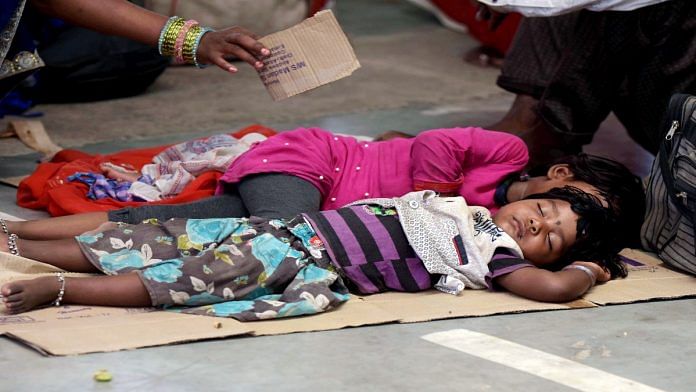New Delhi: As many as 1.2 billion (120 crore) people are multidimensionally poor of which about half 593 million (59.3 crore) are children below the age of 18, according to a report released jointly by the United Nations Development Programme (UNDP) and the Oxford Poverty and Human Development Initiative (OPHI).
Titled the Global Multidimensional Poverty Index (MPI) 2022 report, it came up with new ‘deprivation profiles’ to understand and combat the interconnected features of poverty that exist across the globe.
The “Sustainable Development Goal [SDG] target 1.2 of reducing at least by half the proportion of men, women and children of all ages living in poverty in all its dimensions according to national definitions by 2030 is possible to achieve — and at scale,” said the report published Monday.
The 44-page index, the fourth edition released since 2019, gathered microdata through household surveys for over 6.1 billion (610 crore) people across 111 countries to calculate their Multidimensional Poverty Index (MPI) values.
Using these values, the report identified ‘common deprivation profiles and bundles’ highlighting the combined deprivations experienced by 1.2 billion poor people, nearly double the number of those in monetary poverty. Such data can contribute to designing better, more integrated policies, helping tackle multiple deprivations at once on both a local as well as global level.
Also Read: After World Bank, UNDP says 41.5 cr Indians were lifted from poverty. But it was all before Covid
What index find in India’s context?
The index revealed data on India’s progress in combating poverty, outranking numerous countries in reducing its poverty rate and MPI values.
In the last 15 years, between 2005 and 2016, India lifted 415 million (41.5 crore) people out of poverty, with incidence of poverty declining from 55.1 per cent to 16.4 per cent. This data for India was taken from the National Family Health Survey-5 conducted in 2019-20.
In terms of well-performing states, the poorest state in 2015-16, Bihar saw the fastest reduction in poverty and MPI value, falling from 77.4 per cent in 2005-06 to 34.7 per cent in 2019-21.
Only one (West Bengal) of the 10 poorest states in 2015-2016 did not figure in the poverty list in 2019-2021. The remaining nine states are Bihar, Jharkhand, Meghalaya, Madhya Pradesh, Uttar Pradesh, Assam, Odisha, Chhattisgarh and Rajasthan.
How is the Multidimensional Poverty Index calculated?
The Multidimensional Poverty Index (MPI) value is calculated by multiplying the incidence of poverty and the average intensity of poverty. The MPI ranges from 0 to 1, with higher values implying greater poverty.
While calculating the deprivation score out of 100, the index looked at 10 indicators, each with a specific weightage. These indicators were divided under overall three categories — Health, Education & Standard of Living — with each holding one-third weightage.
Health included nutrition and child mortality, each holding one-sixth weightage. According to the index, a household is deprived of nutrition if any adult under 70 years or any child is undernourished as per their Body Mass Index (BMI).
Education included indicators such as school attendance, each holding one-sixth weightage. A household is considered deprived of school attendance if any school-aged child is not attending school up to the age at which he/she would complete class eight.
Standard of Living includes 6 indicators covering access to cooking fuel to ownership of assets. Each indicator in this category holds 1/18 weightage.
While a household is considered deprived of cooking fuel if it uses dung, wood, charcoal or coal, the same applies to sanitation if the facility is not improved (according to SDG guidelines) or even if it is improved but shared with other households. Drinking water is considered lacking in a household if it does not have improved potable water (according to SDG guidelines) or if takes at least a 30-minute walk from home, round trip for its access.
Similarly, a household is considered deprived of housing if at least one of the three housing materials for roof, walls and floor are inadequate: the floor is of natural materials and/or the roof and/or walls are of natural or rudimentary materials. Another indicator of deprivation is lack of electricity connection.
Lastly, if a household does not own more than one of these assets: radio, television, telephone, computer, animal cart, bicycle, motorbike or refrigerator, and does not own a car or truck, it is considered deprived of assets.
Using these indicators, the index calculated the deprivation score for 111 countries as well as identified the nature of their poverty through deprivation profiles. In India, the most common deprivation profile was of households lacking in housing, sanitation, cooking fuel and nutrition.
This global MPI complements the international $1.90 a day poverty rate, revised by the World Bank last month to $2.15 per day.
(Edited by Anumeha Saxena)
Also Read: Covid reversed poverty decline, made 7.1 cr people poor, says World Bank. At least 1/3 from India



